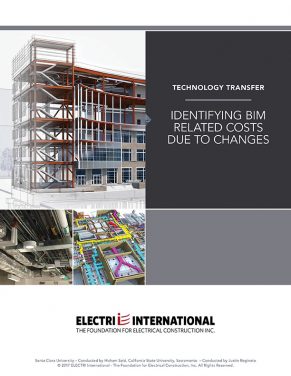Industrialization of Electrical Contracting: Prefabrication and Supply Chain
This report presents the findings of a one-year study funded by ELECTRI International to investigate the determinants and best practices of electrical contracting industrialization. To support the study, a taskforce of electrical construction, supply, and manufacturing professionals was formed to provide the initial input, guidance and results validation. Prefabrication is utilized in this study as a measureable indicator of the industrialization level of electrical construction firms. Accordingly, the study involved three main objectives:
1) Identify and collect best practices of electrical contracting industrialization in terms of prefabrication and supply chain management.
2) Identify industry-related prefabrication feasibility determinants that are out of the electrical contractor’s control, including economic and market parameters.
3) Identify firm-related determinants of prefabrication feasibility that are within the electrical contractor’s control, including operations management and supply chain collaborations.
Logistic regression analysis models were developed to predict the prefabrication feasibility for an electrical contractor by statistically analyzing the data collected in the first phase of research. The appendix of this report presents in detail additional information about the statistical modeling performed.
Statistical Modeling
Two models were developed during this research:
The first model (Model A) suggests that prefabrication feasibility is dependent on the following three variables: union locals’ acceptance of prefabrication outsourcing (unionOutsouce), building information modeling capability (BIM), and strength of the vendor relation with the electrical contractor (vendorRel).
The second model (Model B) suggests that prefabrication feasibility is dependent on the following six variables: unemployment rate (unemploy), average number of employees in the local electrical construction firms (nEmploy), average local electricians’ hourly wage (electWage), union locals’ acceptance of prefabrication outsourcing (unionOutsouce), building information modeling capability (BIM), and the existence of vendor partnership (vendorPartner).
Model B was found to provide more fitting to the analysis data group. However, both models had the same prediction accuracy (75%) when they were applied to the testing data group.





